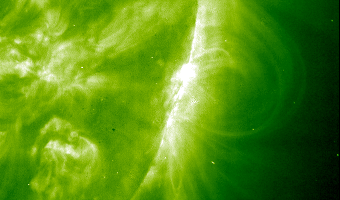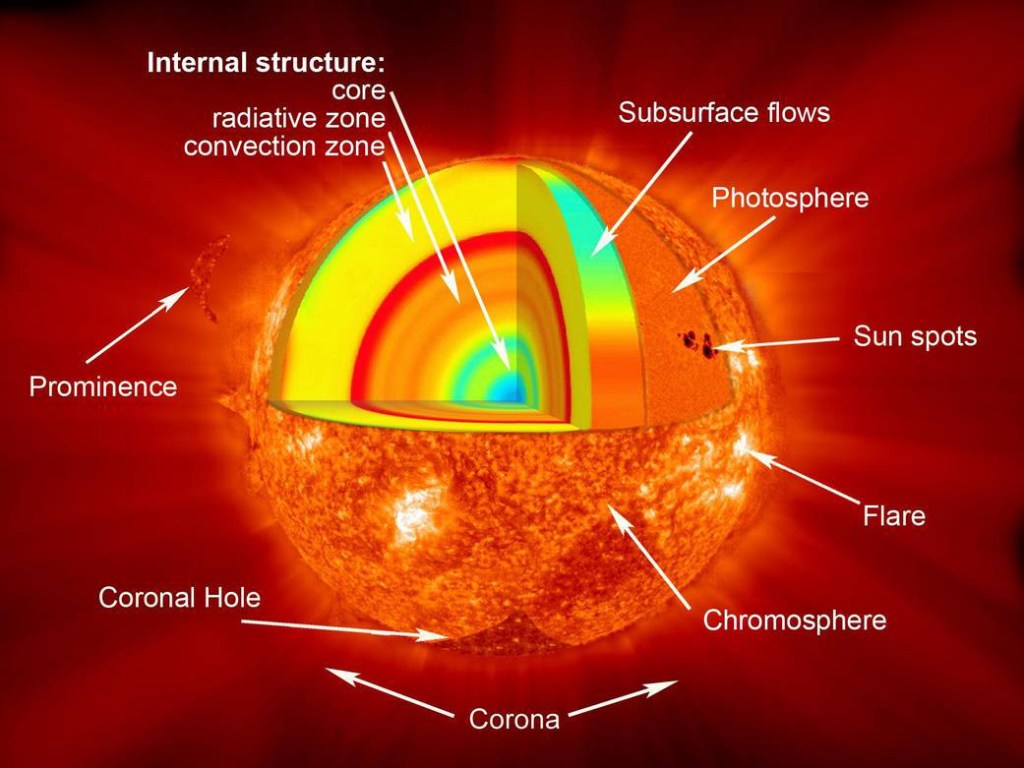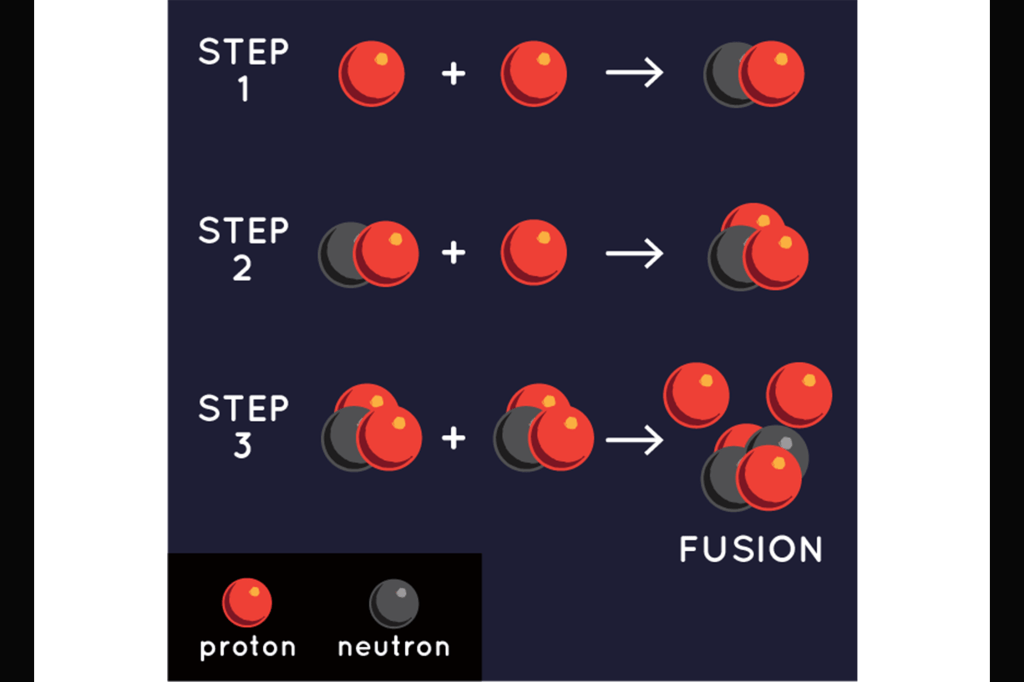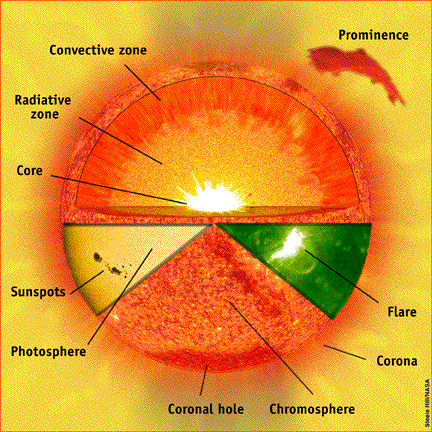Heliophysics Big Idea 3.2
Framework for Heliophysics Education
Quick Facts
Energy from the Sun is created in the core and travels outward through the Sun and into the heliosphere.
Guiding Questions
-
Introductory Learner (K-5)
How does the Sun's energy interact with each one of Earth's major systems (atmosphere, geosphere, biosphere, hydrosphere)?K-PS3-1. Make observations to determine the effect of sunlight on Earth’s surface
K-PS3-2. Use tools and materials to design and build a structure that will reduce the warming effect of sunlight on an area.
2-LS2-1. Plan and conduct an investigation to determine if plants need sunlight and water to grow.
4-PS3-2. Make observations to provide evidence that energy can be transferred from place to place by sound, light, heat, and electric currents.
5-ESS2-1. Develop a model using an example to describe ways the geosphere, biosphere, hydrosphere, and/or atmosphere interact. -
Intermediate Learner (6-8)
How do solar panels work?MS-ESS2-1. Develop a model to describe the cycling of Earth's materials and the flow of energy that drives this process.
MS-ESS3-3. Apply scientific principles to design a method for monitoring and minimizing a human impact on the environment
MS-PS3-3. Apply scientific principles to design, construct, and test a device that either minimizes or maximizes thermal energy transfer.
MS-PS4-2. Develop and use a model to describe that waves are reflected, absorbed, or transmitted through various materials. -
Advanced Learner (9-12+)
How does the Sun make energy?HS-ESS1-1. Develop a model based on evidence to illustrate the life span of the sun and the role of nuclear fusion in the sun’s core to release energy that eventually reaches Earth in the form of radiation.
HS-PS1-8. Develop models to illustrate the changes in the composition of the nucleus of the atom and the energy released during the processes of fission, fusion, and radioactive decay.
HS-PS3-1. Create a computational model to calculate the change in the energy of one component in a system when the change in energy of the other component(s) and energy flows in and out of the system are known.
HS-PS3-4. Plan and conduct an investigation to provide evidence that the transfer of thermal energy when two components of different temperature are combined within a closed system results in a more uniform energy distribution among the components in the system (second law of thermodynamics).

Related Topics By Level For Communicating Heliophysics
Convection
What should learners know about this topic at each level?
Introductory: The rising of warm air and the sinking of cool air. It can also be seen in a pot of boiling water.
Intermediate: Heat mixes and moves air. When a layer of air receives enough heat from the Earth's surface, it expands and moves upward. Colder, heavier air flows under it which is then warmed, expands, and rises. The warm rising air cools as it reaches higher, cooler regions of the atmosphere and begins to sink. Convection causes local breezes, winds, and thunderstorms. Convection also occurs in the Sun, where convection currents help move energy from the core of the Sun to its surface.
Advanced: Convection on the sun occurs in the outer 30% of the solar interior and extends all the way to the surface. Heated plasma at the base of the convection zone becomes bouyant and rises towards cooler regions at the photosphere. As the plasma cools it becomes more dense and then begins to fall back inwards under the force of gravity and become warmer and less dense. The cycle then repeats producing rolling convection cells. This process occurs in an electrically-charged plasma whose motions generate the solar magnetic field in the photosphere and corona.

Corona
What should learners know about this topic at each level?
Introductory: The Sun is a star, but seen up close by us. The Sun is the center of our Solar System and is the largest object in our Solar System. The Sun appears to have been active for 4.6 billion years and has enough fuel for another 5 billion years or so. The Sun has layers like an onion. The Sun is an above-average star in terms of mass, temperature, and size. Most of the stars in our galaxy are smaller, cooler, and less massive than our Sun.
Intermediate: Strong, dynamic magnetic fields on the Sun cause sunspots, solar flares, prominences, and coronal mass ejections. The Sun has six major regions: the core, radiative zone, convective zone, photosphere, chromosphere, and corona. The Sun's layered regions are marked by changes in density, from the highest density in the core to the lowest density in the corona. At the end of its life, the Sun will start to fuse helium into heavier elements and begin to swell up, ultimately growing so large that it will swallow Earth. After a billion years as a 'red giant,' it will suddenly collapse into a 'white dwarf.' It may take a trillion years to cool off completely.
Advanced: Energy moves outward from the core through the radiative zone by way of electromagnetic radiation colliding with matter. Energy moves outward through the convection zone through “convection”: the rising of hot matter that cools and falls, heats up and rises again. The photosphere is a glowing shell of matter at the outer layer of the convection zone. It emits energy primarily as visible light. The chromosphere is a glowing shell of matter between the photosphere and corona. It emits energy primarily as ultraviolet light and is hotter than the photosphere. The corona is the outer atmosphere of the Sun. It emits energy primarily as ultraviolet light and is hotter than the chromosphere. The Sun’s atmosphere blows out into the Solar System as a stream of charged particles called the “solar wind.”
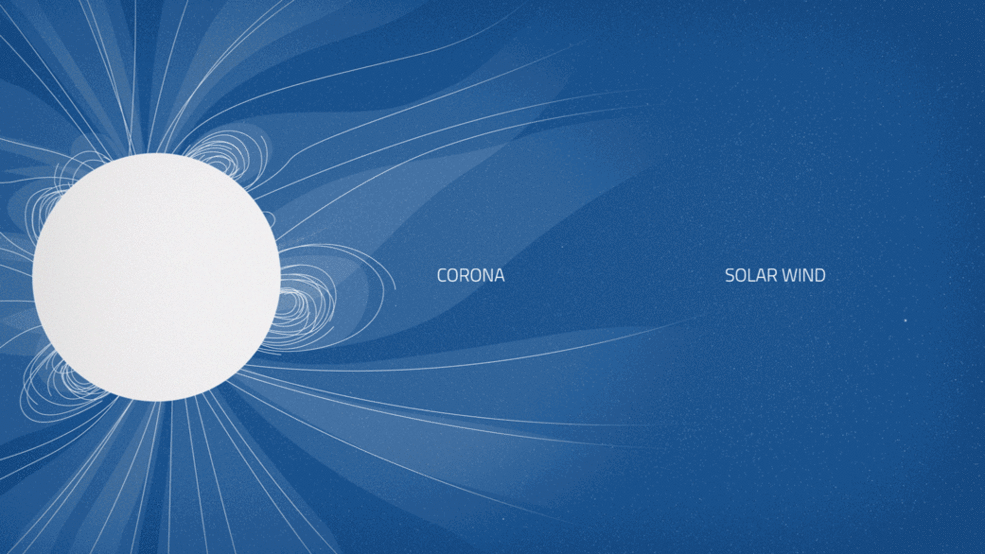
Energy
What should learners know about this topic at each level?
Introductory: The Sun warms the land, air, and water because these materials absorbe the sunlight energy that falls upon them. Sunlight can be converted into electricity using solar panels as a way to run many devices.
Intermediate: There are a great variety of electromagnetic waves: radio waves, microwaves, infrared waves, visible light, ultraviolet rays, X-rays, and gamma rays. These wavelengths vary from radio waves, the longest, to gamma rays, the shortest. Energy in solar processes moves and changes form. Electrical energy can be generated from sunlight, and can be transformed into almost any other form of energy. Energy from the Sun is available indefinitely.
Advanced: Sunlight is the ultimate source of most of the energy we use. The energy in fossil fuels such as oil and coal comes from energy that plants captured from the Sun long ago. Solar panels absorbe sunlight and convert it directly into electricity. On the Sun, magnetic fields contain stored energy, which in a process called magnetic reconnection, can be released to heat up and accelerate local plasma.

Heliosphere
What should learners know about this topic at each level?
Introductory: The solar wind is a flow of particles from the sun’s corona that travels across interplanetary space and blows a bubble in the interstellar matter surrounding the solar system. Everything within the boundaries caused by these interactions is called the “heliosphere.”
Intermediate: The Sun has a magnetic field. The Sun emits a stream of charged particles called the solar wind. The Sun periodically sends out bursts of charged particles and electromagnetic energy so the solar wind varies. The Sun’s magnetic field extends to the far reaches of the solar system. The heliosphere encloses all of the planets and is filled by the Sun’s plasma and magnetic field. In interstellar space outside the heliosphere, the interstellar medium and the galactic magnetic field are dominant. The heliosphere acts as a shield for our solar system, blocking many of the high-energy galactic cosmic rays from elsewhere in our galaxy. Of the spacecraft sent from Earth, only the twin Voyager spacecraft — traveling since 1977 — have been confirmed to have made it beyond the boundaries of the heliosphere.
Advanced: The solar wind causes chemical and electrical reactions on the surfaces of worlds without atmospheres or magnetospheres, like the Moon or asteroids. More energetic particles cause nuclear changes. The solar wind strips away the atmospheres of some planets without large-scale magnetospheres. The solar wind affects the shape of magnetospheres. The giant planets (Jupiter, Saturn, Uranus, Neptune) all have very strong magnetic fields that interact intensely with the solar wind. Worlds without a conducting liquid core (e.g. Mercury, Venus, our Moon, and Mars) do not have large-scale magnetic fields. Only local regions on their surfaces are partially protected from the solar wind by magnetic fields in their crustal rocks. The creation and variability of magnetic dynamos drive the dynamics of solar and stellar environments.

Light
What should learners know about this topic at each level?
Introductory: Electromagnetic energy travels in waves from very long radio waves to very short gamma rays. Humans can only see visitble light. When you tune your radio, watch TV, send a text message, or pop popcorn in a microwave oven, you are using electromagnetic energy. NASA’s scientific instruments use the full range of the electromagnetic spectrum to study the Earth, the solar system, and the universe beyond.
Intermediate: Spectroscopy is the science of reading light to determine the size, distance, spin and chemical composition of distant objects in space. There are a great variety of electromagnetic waves: radio waves, microwaves, infrared waves, visible light, ultraviolet rays, X-rays, and gamma rays. These wavelengths vary from radio waves, the longest, to gamma rays, the shortest. The Sun emits all these types of electromagnetic waves, though in different amounts for various wavelengths. NASA spacecraft use spectrometers to study the composition, physical structure and electronic structure of matter at the atomic, molecular and macro scale, and over astronomical distances.
Advanced: Life is adapted to conditions on the Earth, including an intensity of electromagnetic waves from the Sun that allows water to be present in the liquid state. When electrically charged objects undergo a change in motion, they produce electromagnetic waves around them. Magnetic forces are very closely related to electric forces and are thought of as different aspects of a single electromagnetic force. Moving electrically charged objects produces magnetic forces and moving magnets produces electric forces. In empty space, all electromagnetic waves move at the same speed – the speed of light.

Nuclear Fusion
What should learners know about this topic at each level?
Introductory: Nuclear fusion occurs in the core of the Sun and all stars. Immense pressures and temperatures in the star’s core squeeze the nuclei of hydrogen atoms together to form helium.
Intermediate: Nuclear fusion is a process that produces energy when two nuclei join to form a heavier nucleus. Nuclear fusion releases energy, which heats the star and prevents it from further collapsing under the force of gravity.
Advanced: Astronomers call stars that are stably undergoing nuclear fusion of hydrogen into helium main sequence stars. This is the longest phase of a star’s life. The star’s luminosity, size, and temperature will slowly change over millions or billions of years during this phase. Our Sun is roughly midway through its main sequence stage. A high-mass star goes further. Fusion converts carbon into heavier elements like oxygen, neon, and magnesium, which will become future fuel for the core.
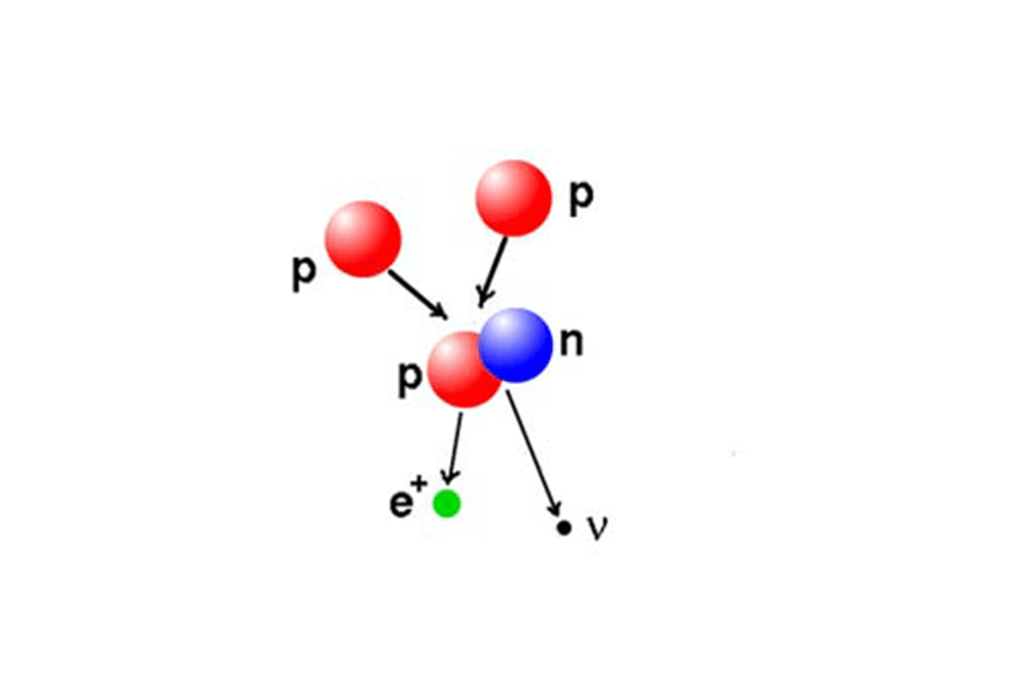
Plasma
What should learners know about this topic at each level?
Introductory: Plasma is the most common, easily observable, state of matter in the universe. All stars, including our Sun, are made of plasma.
Intermediate: Plasma is a gas consisting of electrically charged particles, a state of matter distinct from solids, liquids and gases. Though rare on Earth, plasma makes up over 99% of the observable (i.e., not dark) matter in the universe, including every star, including our Sun, and much of the material between them. On Earth, plasma is found in fluorescent lights, torches used for metalworking, and lightning strikes. Plasma forms when the atoms in a gas become ionized, meaning electrons separate from the atom and move around independently. This makes plasmas electrically charged and they can interact with external electric and magnetic fields. They can also create their own electric and magnetic fields. Plasmas also undergo an explosive process called magnetic reconnection. Magnetic reconnection is a rapid transfer of magnetic energy into motion that powers solar flares and coronal mass ejections.
Advanced: Plasma processes accelerate and transport particles throughout the Sun and the solar system. The existence of charged particles causes plasma to generate, and be affected by, magnetic fields. This can cause extremely complex dynamics. Under certain circumstances, plasmas cannot cross magnetic field lines, though they can slide along them like beads on an elastic string. As a result, a strong plasma can bend weak magnetic fields, and strong magnetic fields can hold back weak plasmas.

Radiation
What should learners know about this topic at each level?
Introductory: Outside the protective cocoon of the Earth’s atmosphere is a universe full of radiation – it is all around us. Radiation can be created by humans (microwaves, cell phones, radios, light bulbs, diagnostic medical applications such as x-rays) or naturally occurring.
Intermediate: Radiation is a form of energy that is emitted in the form of rays, electromagnetic waves, and/or particles. Most of the radiation that the Sun emits is in the form of visible light. Energy appears in different forms and can be transformed and transported within the Sun’s system.
Advanced: Naturally occuring sources of radiation are the Sun, radioactive elements in the Earth’s crust, radiation trapped in the Earth’s magnetic field, stars, and other astrophysical objects like quasars or galactic centers). In some cases, radiation can be seen (visible light) or felt (infrared radiation), while other forms—like x-rays and gamma rays—are not visible and can only be observed with special equipment. Space radiation is different from the kinds of radiation we experience here on Earth. Space radiation is comprised of atoms in which electrons have been stripped away as the atom accelerated in interstellar space to speeds approaching the speed of light – eventually, only the nucleus of the atom remains.
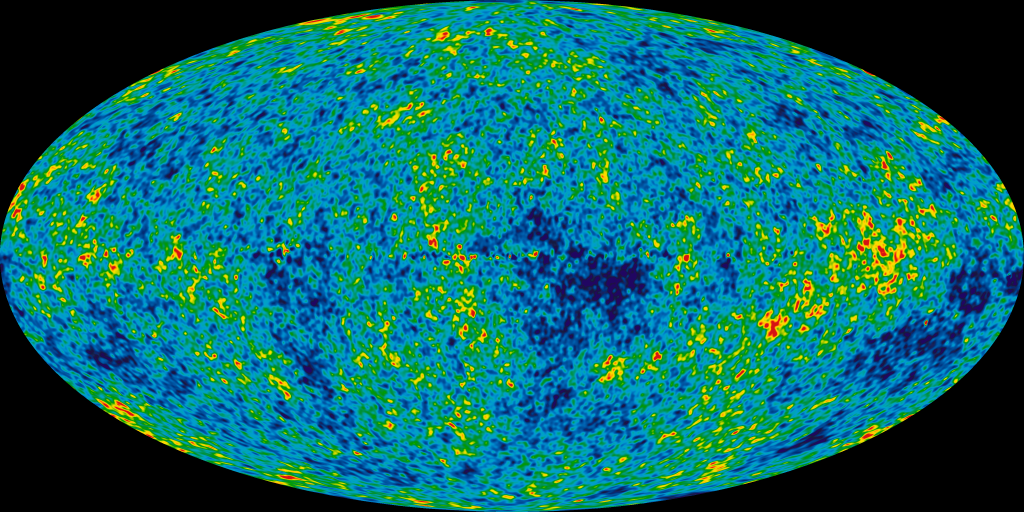
Solar Wind
What should learners know about this topic at each level?
Introductory: The solar wind is a gusty stream of material that flows from the Sun in all directions, all the time, carrying the Sun’s magnetic field out into space.
Intermediate: While it is much less dense than wind on Earth, solar wind is much faster, typically blowing at speeds of one to two million miles per hour. The solar wind is made of charged particles — electrons and ionized atoms — that interact with each other and the Sun’s magnetic field. The extent of the solar wind creates the heliosphere, the Sun’s region of influence within interstellar space.
Advanced: The origin of the solar wind seems to be in the corona of the sun where magnetic fields are ‘reconnecting’ and depositing energy into the coronal plasma. This plasma becomes hot enough to escape the gravitational influence of the Sun and flow out into interplanetary space.

Space Weather
What should learners know about this topic at each level?
Introductory: Space weather refers to conditions in space produced by the Sun’s activity. Prediction of space weather helps to protect human in space, technology, communications, and power systems on Earth. Solar flares are the most powerful explosions in the solar system. The energetic particles accelerated by flares travel nearly at the speed of light, and can travel the 93 million miles between the Sun and Earth in less than 20 minutes.
Intermediate: A geomagnetic storm is a major disturbance of Earth’s magnetosphere that occurs when there is a very efficient exchange of energy from the solar wind and coronal mass ejections into the space environment surrounding Earth. Space weather is the interaction of matter and energy from the Sun with magnetic fields such as Earth’s. Radio blackouts occur when the strong, sudden burst of x-rays from a solar flare hits Earth’s atmosphere, disturbing high and low frequency waves in the ionosphere. The loss of low frequency radio communication causes GPS measurements to be off by feet to miles, and can also affect the applications that govern satellite positioning.
Advanced: Variable features of the Sun due to strong, dynamic magnetic fields include sunspots, solar flares, prominences, and coronal mass ejections (CMEs). These processes occur on a variety of time scales, from minutes to years. Solar flares are energetic bursts of light and particles triggered by the release of magnetic energy on the Sun. Geomagnetic storms result from variations in the solar wind that produces major changes in the currents, plasmas, and fields in Earth’s magnetosphere. The solar wind conditions that are effective for creating geomagnetic storms are sustained (for several to many hours) periods of high-speed solar wind, and most importantly, a southward directed solar wind magnetic field (opposite the direction of Earth’s field) at the dayside of the magnetosphere. This condition is effective for transferring energy from the solar wind into Earth’s magnetosphere.

Heliophysics Resource Database
Use the guiding questions above to explore resources at each level or go directly to our database to search for resources by level, NGSS performance expectation, topic, and mission.
Resource Database